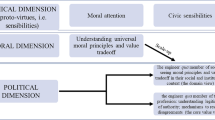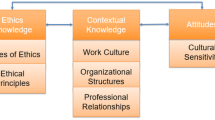Abstract
In this essay I discuss a novel engineering ethics class that has the potential to significantly decrease the likelihood that students (and professionals) will inadvertently or unintentionally act unethically in the future. This class is different from standard engineering ethics classes in that it focuses on the issue of why people act unethically and how students (and professionals) can avoid a variety of hurdles to ethical behavior. I do not deny that it is important for students to develop cogent moral reasoning and ethical decision-making as taught in traditional college-level ethics classes, but as an educator, I aim to help students apply moral reasoning in specific, real-life situations so they are able to make ethical decisions and act ethically in their academic careers and after they graduate. Research in moral psychology provides evidence that many seemingly irrelevant situational factors affect the moral judgment of most moral agents and frequently lead agents to unintentionally or inadvertently act wrongly. I argue that, in addition to teaching college students moral reasoning and ethical decision-making, it is important to: 1. Teach students about psychological and situational factors that affect people’s ethical judgments/behaviors in the sometimes stressful, emotion-laden environment of the workplace; 2. Guide students to engage in critical reflection about the sorts of situations they personally might find ethically challenging before they encounter those situations; and 3. Provide students with strategies to help them avoid future unethical behavior when they encounter these situations in school and in the workplace.
Similar content being viewed by others
Notes
In this case, we may believe that a second ethical rule supersedes or outweighs the first rule. Or we may justify our behavior by appealing to consequentialism or utilitarianism.
Carpenter et al. (2010) assert that a large number of students rationalize cheating. For example, in their survey, over 20 % of the students disagreed with the following statement: “It is wrong to cheat even if the instructor has done an inadequate job of teaching the course.” Similarly, more than 15 % of the students disagreed with the following: “It is wrong to cheat even if the instructor didn’t seem to care if I learned the material.” Students who disagree with these statements may believe that it is not truly wrong to cheat in some instances.
In addition, engineering students may believe that cheating is not unethical or that it is not really wrong. As Carpenter et al. (2010) assert: “61.1 % of engineering undergraduates indicated that faculty and students had either little or no understanding of the academic policies of their institution and nearly half of them thought faculty did not support those policies.” If students believe that their professors do not support academic dishonesty policies, they may come to believe that these policies are not a true reflection of what is wrong or unethical.
Carpenter et al. (2010) assert that students are “more apt to cheat if they perceive they would feel no shame or embarrassment if discovered. Likewise, students who see little threat of being caught by their institution are also more likely to cheat.” That said, Carpenter et al. do propose six interventions that they believe may decrease academic dishonesty, pp. 1161–1162.
Doris seems to believe that situation is the dominant factor affecting ethical judgment (in a large variety of cases).
I recognize that this was a small study, but the data are striking.
One of the attributes of virtue ethics is that it seems to explain why people act ethically or unethically. If a person is virtuous—if she has internalized praiseworthy character traits, like compassion and loyalty—she will do the right thing when faced with an ethical challenge. Many of us believe that if we instill the virtues in our children, they will (usually or habitually) act ethically or virtuously. If we teach our children to be caring, helpful people, they will (usually or habitually) help those in need of assistance.
Researchers gave participants in these groups the opportunity to cheat by placing two envelopes on each participant’s desk before they arrived. One envelope contained 20 quarters and the other was empty. Participants were to keep one quarter for every matrix they solved correctly, and to transfer the remaining quarters to the empty envelope and leave it on the desk.
This study was replicated several years ago; see, Gino et al. (2011).
In the same paper in which the results of the experiment described above were reported, the authors conducted an experiment, which involved the same writing task, that demonstrates that self-control resources depletion may lower people’s ability to recognize unethical behavior since ethicality is not activated in their minds when facing an ethical dilemma due to the taxed cognitive resources required to think through ethical dilemmas (p. 197).
One might also claim that virtue is extraordinarily rare, and that, therefore, it is unlikely that the agents in the phone booth case were virtuous (Sreenivasan 2002). If, as these theorists claim, virtue is obtained only by those rare individuals who devote their lives to virtue, the phone booth example does not pose a problem for virtue ethics.
Interestingly, Haidt and several others claim that we engage in post hoc reasoning when we attempt to provide a rational justification for a moral judgment. Furthermore, they suggest that this post hoc reasoning is unconscious or that we are unaware that we engage in this form of reasoning (See, Prinz 2007, p. 31; Haidt 2001, 2005).
Thaler and Sunstein (2008, chapter 3) provide an interesting discussion of the ways in which social influences affect judgment.
Although this model is committed to two levels, these levels may not be distinct. Hence, it may be more accurate or clear to conceive of level-1 and level-2 as endpoints on a continuum. At any given time, a person may be at level-1, somewhere between level-1 and level-2 or at level-2.) Furthermore, a more complete model (which is not necessary for the purposes of this essay) might have more than two levels.
This seminar could easily be modified for students in the sciences.
Although this seminar was developed as a stand-alone class, it could be part of a more comprehensive course.
To make the study relevant, a drink vending machine was used instead of a telephone booth.
Although some situationists focus on avoiding dangerous situations, this seminar tries to teach students about what types of situations are dangerous and how they can decrease the danger by being mindful when they are in these situations. Sarkissian (2010) argues for a similar approach.
Harris (2013, 35) asserts that this kind of group has the potential to decrease unethical behavior.
Kawakami et al. (2000) demonstrate that through practice, people can reduce stereotype activation.
References
Annas, J. (2005). Comments on John Doris’s Lack of Character. Philosophy and Phenomenological Research, 71(3), 636–642.
Asch, S. (1995). Opinions and social pressure. In E. Aronson (Ed.), Readings about the social animal. New York: W. H. Freeman.
Carpenter, D. D., Harding, T. S., & Finelli, C. J. (2010). Using research to identify academic dishonesty deterrents among engineering undergraduates. International Journal of Engineering Education, 26(5), 1156–1165.
Cialdini, R. B. (2001). Influence: Science and practice. Boston, MA: Allyn and Bacon.
Darby, B. W., & Jeffers, D. (1988). The effects of defendant and juror attractiveness on simulated courtoom trial decisions. Social Behavior and Personality: An International Journal, 16(1), 39–50.
Dijksterhuis, A., & Van Knippenberg, A. (2000). Behavioral indecision: Effects of self-focus on automatic behavior. Social Cognition, 18(1), 55–74.
Doris, J. M. (1998). Persons, situations, and virtue ethics. Nous, 32(4), 504–530.
Flannigan, O. (1991). Varieties of moral personality: Ethics and psychological realism. Cambridge: Harvard University Press.
Forgas, J. P., & Bower, G. H. (1987). Mood effects on person-perception judgments. Journal of Personality and Social Psychology, 53(1), 53–60.
Gaudine, A., & Thorne, L. (2001). Emotion and ethical decision-making in organizations. Journal of Business Ethics, 31(2), 175–187.
Gino, F., Schweitzer, M. E., Mead, N. L., & Ariely, D. (2011). Unable to resist temptation: How self-control depletion promotes unethical behavior. Organizational Behavior and Human Decision Processes, 115, 191–203.
Greene, J., & Haidt, J. (2002). How (and where) does moral judgment work? Trends in Cognitive Sciences, 6(12), 517–523.
Haidt, J. (2001). The emotional dog and its rational tail: A social intuitionist approach to moral judgment. Psychological Review, 108(4), 814–834.
Haidt, J. (2005). Invisible fences of the moral domain (Commentary: Sunstein, C. Moral Heuristics). Behavioral and Brain Sciences, 28(4), 552–553.
Harding, T. S., Carpenter, D. D., Finelli, C. J., & Passow, H. J. (2004). Does academic dishonesty relate to unethical behavior in professional practice? An Exploratory Study. Science and Engineering Ethics, 10(2), 311–324.
Harris, C. (2013). Teaching virtue ethics: The implications of “Situationism”. Teaching Ethics, 13(2), 23–37.
Isen, A. M., & Levin, P. F. (1972). Effect of feeling good on helping: Cookies and kindness. Journal of Personality and Social Psychology, 21(3), 384–388.
James, H. S. (2000). Reinforcing ethical decision making through organizational structure. Journal of Business Ethics, 28(1), 43–58.
Kawakami, K., Dovidio, J., Moll, J., Hermsen, S., & Russin, A. (2000). Just say no (to stereotyping): Effects of training in the negation of stereotypic associations on stereotype activation. Journal of Personality and Social Psychology, 78(5), 871–888.
Mathews, G., Deary, I., & Whiteman, M. (1998). Personality traits. Cambridge, UK: Cambridge University Press.
Mead, N. L., Baumeister, R. F., Gino, F., Schweitzer, M. E., & Ariely, D. (2009). Too tired to tell the truth: Self-control resource depletion and dishonesty. Journal of Experimental Social Psychology, 45(3), 594–597.
Miller, C. (2003). Social psychology and virtue ethics. The Journal of Ethics, 7(4), 365–392.
Plato. (1979). Gorgias (T. Irwin, Trans.). Oxford: Clarendon Press.
Powell, S. T., Allison, M. A., & Kalichman, M. W. (2007). Effectiveness of a responsible conduct of research course: A Preliminary Study. Science and Engineering Ethics, 13(2), 249–264.
Prinz, J. (2007). The emotional construction of morals. Oxford: Oxford University Press.
Recker, D. (2010). How to confuse organisms with mousetraps: Machine metaphors and intelligent design. Zygon, 45(3), 647.
Sarkissian, H. (2010). Minor tweaks, major payoffs: The problems and promise of situationism in moral philosophy. Philosophers’ Imprint, 10(9), 1–15.
Sauer, H. (2012). Educated intuitions. Automaticity and rationality in moral judgment. Philosophical Explorations, 15(3), 255–275.
Schnall, S., Haidt, J., Clore, G. L., & Jordan, A. H. (2008). Disgust as embodied moral judgment. Personality and Social Psychology Bulletin, 34(8), 1096–1109.
Sloman, S. A. (1996). The empirical case for two systems of reasoning. Psychological Bulletin, 119(1), 3–22.
Sreenivasan, G. (2002). Errors about errors: Virtue theory and trait attribution. Mind, 111(141), 47–68.
Taylor, C. (1989). Sources of the self: The making of the modern identity. Cambridge, MA: Harvard University Press.
Texas Board of Engineers website. http://engineers.texas.gov. Disciplinary actions, November 20, 2014; February 12, 2015; and May 21, 2015.
Thaler, R., & Sunstein, C. (2008). Nudge: Improving decisions about health, wealth and happiness. New Haven: Yale University Press.
Valdesolo, P., & DeSteno, D. (2006). Manipulations of emotional context shape moral judgment. Psychologogical Science, 17(6), 476–477.
Wason, P. C., & Evans, J. S. B. T. (1974). Dual processes in reasoning? Cognition, 3(2), 141–154.
Wheatley, T., & Haidt, J. (2005). Hypnotic disgust makes moral judgments more severe. Psychological Science, 16(10), 780–784.
Author information
Authors and Affiliations
Corresponding author
Additional information
This development of the ethics seminar discussed in this essay was funded by the National Science Foundation. I dedicate this essay to Steve Harrist, a former colleague, co-investigator and friend.
Rights and permissions
About this article
Cite this article
Gelfand, S.D. Using Insights from Applied Moral Psychology to Promote Ethical Behavior Among Engineering Students and Professional Engineers. Sci Eng Ethics 22, 1513–1534 (2016). https://doi.org/10.1007/s11948-015-9721-6
Received:
Accepted:
Published:
Issue Date:
DOI: https://doi.org/10.1007/s11948-015-9721-6




